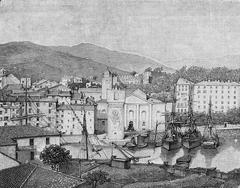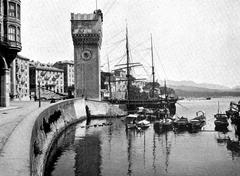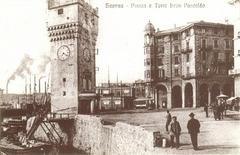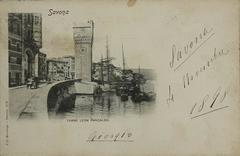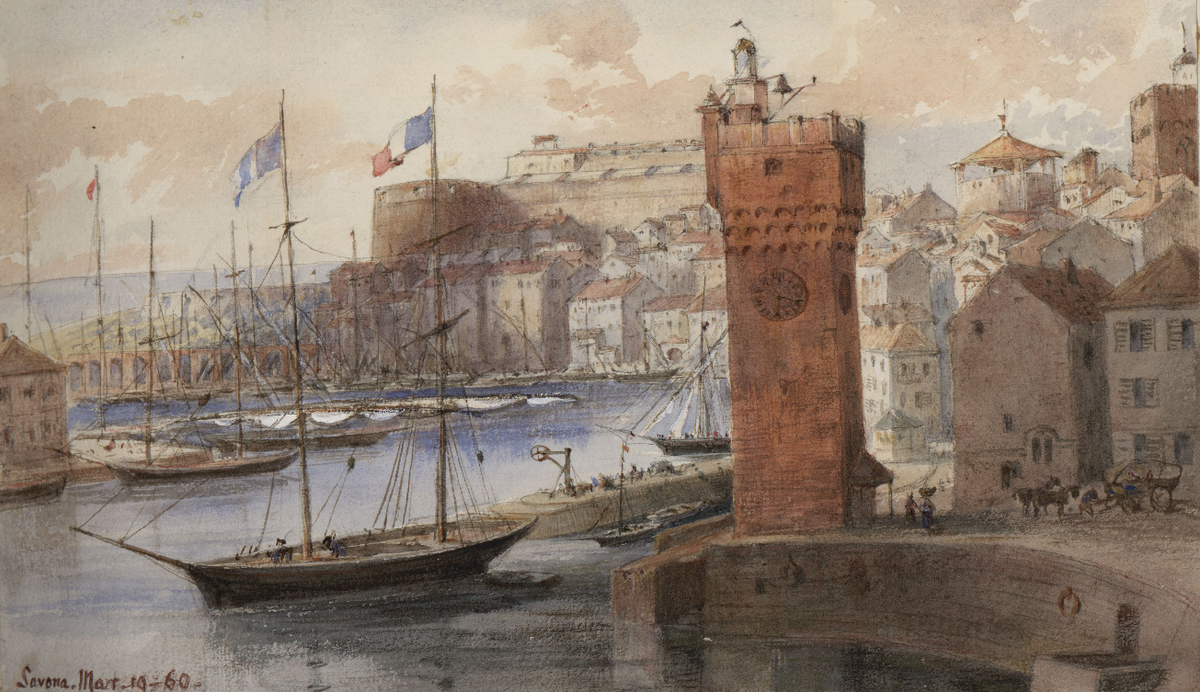
Visiting Torretta in Celle Ligure: Hours, Tickets, and Tips
Date: 19/07/2024
Introduction
Nestled along the picturesque Ligurian coast, Torretta in Celle Ligure, Italy, stands as a historical gem waiting to be explored. Rich in cultural heritage and historical significance, Torretta offers visitors a unique glimpse into the past, from its ancient Ligurian roots to its Renaissance splendor. This charming hamlet within the municipality of Celle Ligure has evolved through the ages, reflecting the various epochs that have left their mark on its architecture and way of life. Whether you’re a history enthusiast, a culture aficionado, or simply looking for a scenic travel destination, Torretta promises an enriching experience. This comprehensive guide will delve into the multifaceted history of Torretta, provide practical visitor information, and offer valuable travel tips to ensure an unforgettable visit. For those eager to immerse themselves in the rich tapestry of Italian history and culture, Torretta is a must-see destination (Liguria Heritage, Celle Ligure Tourism).
Table of Contents
- Introduction
- Early Beginnings
- Roman Influence
- Medieval Period
- Renaissance and Baroque Eras
- Modern Era
- Cultural Significance
- Visitor Information
- Frequently Asked Questions (FAQ)
- Conclusion
Early Beginnings
Torretta, a charming hamlet within the municipality of Celle Ligure, Italy, boasts a rich history that dates back to ancient times. The region’s earliest known inhabitants were the Ligurians, an ancient Indo-European people who settled in the area during the Iron Age. Archaeological findings suggest that the Ligurians established small communities along the coast, benefiting from the region’s fertile land and strategic maritime position.
Roman Influence
The Roman Empire’s expansion into Liguria in the 2nd century BCE marked a significant turning point for Torretta and its surroundings. The Romans recognized the strategic importance of the Ligurian coast and established several settlements to secure their control over the region. Evidence of Roman presence in Torretta includes remnants of ancient roads, villas, and artifacts, indicating that the area was integrated into the broader Roman trade network. The construction of the Via Aurelia, a major Roman road connecting Rome to the western provinces, further facilitated the region’s development and integration into the empire.
Medieval Period
Following the fall of the Roman Empire, Torretta and Celle Ligure experienced a period of relative obscurity. The region was subjected to various invasions and power struggles, including the Lombards, Byzantines, and Saracens. By the 10th century, the area came under the control of the Republic of Genoa, a powerful maritime republic that dominated the Ligurian coast.
During the medieval period, Torretta’s strategic location made it a valuable asset for the Genoese. The construction of defensive structures, such as watchtowers and fortifications, was a common practice to protect against pirate raids and rival maritime powers. The name “Torretta” itself is derived from the Italian word for “small tower,” reflecting the hamlet’s historical role in coastal defense.
Renaissance and Baroque Eras
The Renaissance period brought a resurgence of economic and cultural activity to Torretta and Celle Ligure. The Genoese Republic’s prosperity during this time led to increased trade and maritime activity along the Ligurian coast. Torretta benefited from this economic boom, with the construction of elegant villas and churches that showcased the architectural styles of the Renaissance and Baroque eras.
One notable example is the Church of San Michele Arcangelo, a beautiful Baroque church located in Celle Ligure. Built in the 17th century, the church features intricate frescoes, ornate altars, and stunning architectural details that reflect the artistic achievements of the period. The church remains a significant cultural and historical landmark in the region.
Modern Era
The 19th and 20th centuries brought significant changes to Torretta and Celle Ligure. The unification of Italy in 1861 and the subsequent industrialization of the country had a profound impact on the region. The construction of the Genoa-Ventimiglia railway line in the late 19th century improved connectivity and accessibility, leading to increased tourism and economic development.
During World War II, Torretta and Celle Ligure, like many other parts of Italy, experienced the hardships of conflict. The region was occupied by German forces, and the local population endured significant challenges. However, the post-war period saw a resurgence of growth and development, with the tourism industry playing a crucial role in the region’s recovery.
Cultural Significance
Today, Torretta and Celle Ligure are celebrated for their rich cultural heritage and historical significance. The hamlet’s well-preserved architecture, charming streets, and scenic coastal views attract visitors from around the world. Torretta’s historical landmarks, such as the ancient watchtowers and the Church of San Michele Arcangelo, offer a glimpse into the region’s storied past.
The local community takes pride in preserving and promoting their cultural heritage. Festivals, events, and cultural activities are regularly organized to celebrate the region’s history and traditions. One such event is the “Festa di San Michele,” a religious festival held in honor of the patron saint of Celle Ligure. The festival features processions, music, and traditional Ligurian cuisine, providing visitors with an immersive cultural experience.
Visitor Information
For tourists interested in exploring Torretta’s historical and cultural heritage, several tips can enhance their visit:
-
Guided Tours - Consider joining a guided tour to gain deeper insights into Torretta’s history and landmarks. Local guides can provide valuable context and stories that enrich the experience.
-
Historical Sites - Visit key historical sites such as the Church of San Michele Arcangelo and the ancient watchtowers. These landmarks offer a fascinating glimpse into the region’s past.
-
Local Cuisine - Don’t miss the opportunity to sample traditional Ligurian cuisine. Local restaurants and trattorias serve dishes such as pesto alla Genovese, focaccia, and fresh seafood, providing a taste of the region’s culinary heritage.
-
Festivals and Events - Check the local event calendar for festivals and cultural events. Participating in these celebrations offers a unique opportunity to experience the local culture and traditions.
-
Scenic Walks - Take leisurely walks along the coastal paths and through the charming streets of Torretta and Celle Ligure. The picturesque views and historic architecture make for a memorable experience.
Frequently Asked Questions (FAQ)
-
What are the visiting hours for Torretta?
- Visiting hours for Torretta may vary depending on the season and specific attractions. It is recommended to check the official website or contact local tourism offices for the most up-to-date information.
-
Are there guided tours available in Torretta?
- Yes, guided tours are available in Torretta. Local guides offer tours that provide in-depth insights into the history and landmarks of the region.
-
What is the best time to visit Torretta?
- The best time to visit Torretta is during the spring and summer months when the weather is pleasant, and various cultural events and festivals take place.
-
Are there any ticket prices for visiting historical sites in Torretta?
- Some historical sites in Torretta may have ticket prices. It is advisable to check in advance for any entry fees and ticket information.
-
What are some nearby attractions to Torretta?
- Nearby attractions include the larger town of Celle Ligure, the beautiful beaches along the Ligurian coast, and other historical sites in the region.
Conclusion
Torretta in Celle Ligure is more than just a historical monument; it is a symbol of the region’s rich cultural heritage and resilience through the ages. From its early beginnings with the Ligurians to its strategic importance during the Roman and medieval periods, Torretta has played a significant role in the history of the Ligurian coast. The Renaissance and Baroque eras further enriched its architectural landscape, making it a treasure trove for history buffs and architecture enthusiasts alike. Today, Torretta continues to attract visitors from around the world, offering a unique blend of historical landmarks, cultural festivals, and scenic beauty. Whether you’re exploring its ancient watchtowers, savoring local Ligurian cuisine, or participating in vibrant local festivals, Torretta provides a holistic travel experience that caters to diverse interests. For those planning a visit, this guide offers all the essential information to make your trip both enjoyable and memorable. Don’t forget to check out the official Celle Ligure tourism website for the latest updates and events (Celle Ligure Tourism).
References
- Exploring Torretta, Celle Ligure - History, Visiting Hours, and Travel Tips, 2024, Audiala (Liguria Heritage)
- Visiting Torretta in Celle Ligure - History, Tickets, and Travel Tips, 2024, Audiala (Architectural Digest)
- Complete Guide to Visiting Torretta in Celle Ligure - History, Tickets, and Travel Tips, 2024, Audiala (Celle Ligure Tourism)

